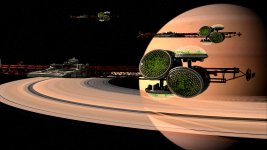Gregory Benford and Larry Niven utilise the concept of the Shkadov Thruster in their novel Bowl of Heaven and its sequel Shipstar.Oooooh! Guys, this looks good, it's under the Dyson Sphere link in the previous post:
The idea of being able to cruise our entire solar system to a younger star is truly a fantastic concept. The Shkadov Thruster could give us a brand new lease of life by enabling us to swap our sun for another!When the crew of the Sunseeker investigates a gigantic, bowl-shaped object with a sun at the centre, their landing parties seek to unravel the mysteries of the gargantuan artefact known as the Shipstar.
Attachments
No wonder you loose your shirt on the nags, Steve!I make 20 m/s to be 45 mph. It'd be quicker to ride a horse.
According to the Guinness Book of Records, the fastest speed of a racehorse ever reported was approximately 44 mph.

The only real options for travel beyond the solar system seem to be multi-generational voyages where the human crew replaces itself many times over during the journey. To me that seems like enslaving generations of your descendants to a prison they had no role in choosing. I can't understand how a person could make this choice for their children, grandchildren, great-grandchildren...
Yes indeed, Kevin. We would have to look carefully at the ethics involved in multigenerational interstellar travel.
However, committing others to conditions not of their own choosing already happens here on Earth.
Ooops! I may be steering our starship too far off course!
However, committing others to conditions not of their own choosing already happens here on Earth.
Ooops! I may be steering our starship too far off course!

I had one of my better weekends on the Nags as it goes. I do concede that one of my 9/2 picks Glass Slippers | Horse Profile | Sky Sports Horse Racing does 35 mph. 5F in one minute.
This Shkradov Drive is however hopeless:
We shouldn't forget that our solar system already has a proper motion of 13.4 km/s relative to some local stars. IIRC, Arcturus has moved the width of the moon in the skies in the last 2,000 years. We are also on our way towards Summer Star Vega which is 26 light years away.
Usual back of a beermat stuff gets us whizzing past it in 600,000 years. Better than a Shkradov Drive, anyway.
This Shkradov Drive is however hopeless:
For a star such as the Sun, with luminosity 3.85 × 10^26 W and mass 1.99 × 10^30 kg, the total thrust produced by reflecting half of the solar output would be 1.28 × 10^18 N. After a period of one million years this would yield an imparted speed of 20 m/s, with a displacement from the original position of 0.03 light-years.
We shouldn't forget that our solar system already has a proper motion of 13.4 km/s relative to some local stars. IIRC, Arcturus has moved the width of the moon in the skies in the last 2,000 years. We are also on our way towards Summer Star Vega which is 26 light years away.
Usual back of a beermat stuff gets us whizzing past it in 600,000 years. Better than a Shkradov Drive, anyway.
Yes but....I had one of my better weekends on the Nags as it goes. I do concede that one of my 9/2 picks Glass Slippers | Horse Profile | Sky Sports Horse Racing does 35 mph. 5F in one minute.
This Shkradov Drive is however hopeless:
We shouldn't forget that our solar system already has a proper motion of 13.4 km/s relative to some local stars. IIRC, Arcturus has moved the width of the moon in the skies in the last 2,000 years. We are also on our way towards Summer Star Vega which is 26 light years away.
Usual back of a beermat stuff gets us whizzing past it in 600,000 years. Better than a Shkradov Drive, anyway.
Sure it helps to gain speed right when starting going to a star speeding to us at high velocity. The trouble is at the arrival, you better have good brakes.
There is no free lunch.
No wonder you loose your shirt on the nags, Steve!
According to the Guinness Book of Records, the fastest speed of a racehorse ever reported was approximately 44 mph.
My big poodle Alfie will do more than 30 on a good day. I suppose when he gets to 2 or 3 yrs old he’ll hit 35 or so. Not quite greyhound territory but then again poodles are renowned for their stamina. And my goodness they do look good. When I take him to the garden centre, especially if he’s been groomed in tne last day or two, all the women want to stroke him.
Where I have got to on Starships is you can either get to a nearby Star in about 40 years for a flyby mission, Or slow down and land in about 80 years:
Project Daedalus – Interstellar Mission
Just a question of whether you use the second stage in one direction or the other.
Probably a bit unlikely that any sane human would sign up for either mission. I'd die of boredom even with Netflix. And the time lag would rule out betting on the nags.
Robot probes look much better. Huge advances in artificial intelligence likely in the near future. Information Theory tells us we can communicate with these probes, albeit with a time lag. Telescopes are getting amazingly good at detecting exoplanets and other things of interest to select a promising destination. Slight question mark over Fusion propulsion, but who knows?
TBH, I think we'll be getting images and experiments beamed from nearby stars and their planets in a few hundred years time. Just like Cassini did with Saturn, and the Mars Rover did in our present era.
Project Daedalus – Interstellar Mission
Just a question of whether you use the second stage in one direction or the other.
Probably a bit unlikely that any sane human would sign up for either mission. I'd die of boredom even with Netflix. And the time lag would rule out betting on the nags.
Robot probes look much better. Huge advances in artificial intelligence likely in the near future. Information Theory tells us we can communicate with these probes, albeit with a time lag. Telescopes are getting amazingly good at detecting exoplanets and other things of interest to select a promising destination. Slight question mark over Fusion propulsion, but who knows?
TBH, I think we'll be getting images and experiments beamed from nearby stars and their planets in a few hundred years time. Just like Cassini did with Saturn, and the Mars Rover did in our present era.
Last edited:
Will have to read those, thanks.Gregory Benford and Larry Niven utilise the concept of the Shkadov Thruster in their novel Bowl of Heaven and its sequel Shipstar.
Cruising in style, the best spaceship is no spaceship.The idea of being able to cruise our entire solar system to a younger star is truly a fantastic concept. The Shkadov Thruster could give us a brand new lease of life by enabling us to swap our sun for another!
It's not fast, but more or less constantly accellerating, and no need to add fuel.This Shkradov Drive is however hopeless:
We shouldn't forget that our solar system already has a proper motion of 13.4 km/s relative to some local stars. IIRC, Arcturus has moved the width of the moon in the skies in the last 2,000 years. We are also on our way towards Summer Star Vega which is 26 light years away.
Usual back of a beermat stuff gets us whizzing past it in 600,000 years. Better than a Shkradov Drive, anyway.
Perhaps not better than, but it's certainly less effort
My, my... And in broad daylight!all the women want to stroke him.
I wonder if Dewey will get rescued by some friendly aliens and allowed to set up a farmer's market on some far flung planet?Bruce Dern, "Silent Running". Silent Running (1972) - IMDb
Attachments
The first candidate for exploration would be Proxima b, the closest exoplanet to our Solar System.Telescopes are getting amazingly good at detecting exoplanets and other things of interest to select a promising destination.
It orbits Proxima Centauri, which is a red dwarf star and our nearest stellar neighbour. Proxima b could have a stable climate and life on its surface.
Attachments
Don’t know the distance from the star, but most planets in the Goldilocks zone around a red dwarf are tidally locked, so huge temp differentials between the two halves of the planet.
Stormy I’d say. The other issue is they tend to flare up dangerously within minutes.
I am a ‘the glass is empty’ guy when it comes to this sort of thing.
Might be a large moon orbiting a large Jupiter size planet around a red dwarf if a better bet.
Stormy I’d say. The other issue is they tend to flare up dangerously within minutes.
I am a ‘the glass is empty’ guy when it comes to this sort of thing.
Might be a large moon orbiting a large Jupiter size planet around a red dwarf if a better bet.
Last edited:
I was hoping to rewatch Silent Running on YouTube, but it wouldn't play for some reason.
Apparently largely filmed on an old US Aircraft Carrier. The Drones were played by amputee actors. Walking on their hands in effect. The Drones were cute.
Apparently 63 stars within 15 lightyears.
List of nearest stars and brown dwarfs - Wikipedia
Of which 13 are Sun sized. The rest being smaller red dwarfs and such.
They get close sometimes:
Scholz came within 0.8 LY 70,000 years back:
Scholz's Star - Wikipedia
Gliese 710 is due to pass within 0.2 LY in 1.3 Million Years
Gliese 710 - Wikipedia
Close enough to loosen a shower of comets from the Oort Cloud.
Apparently largely filmed on an old US Aircraft Carrier. The Drones were played by amputee actors. Walking on their hands in effect. The Drones were cute.
Apparently 63 stars within 15 lightyears.
List of nearest stars and brown dwarfs - Wikipedia
Of which 13 are Sun sized. The rest being smaller red dwarfs and such.
They get close sometimes:
Scholz came within 0.8 LY 70,000 years back:
Scholz's Star - Wikipedia
Gliese 710 is due to pass within 0.2 LY in 1.3 Million Years
Gliese 710 - Wikipedia
Close enough to loosen a shower of comets from the Oort Cloud.
Yes, red dwarf stars, which are the most common star in the Universe (accounting for 75 percent of stars in the Milky Way alone) have a tendency to blast their planets with harmful radiation.Stormy I’d say. The other issue is they tend to flare up dangerously within minutes.
Perhaps the presence of a thick atmosphere and cloud cover would allow life to emerge on Proxima b. Or it could be a 'water world', sheltering life in the depths of its oceans. We can always dream!
I am entirely happy with the situation.
No need to "rub it in".
I'm beginning to suspect your wife is making a very accurate assessment of the situation
We can always dream!
I think the first thing to dream about would have to be what we can do within our solar system.
Right now we have 1 marble on which we are able to live, what would be the best course of action to expand that number to 2?
- Status
- Not open for further replies.
- Home
- Member Areas
- The Lounge
- What is the Universe expanding into..





